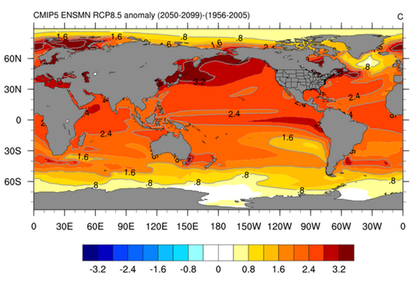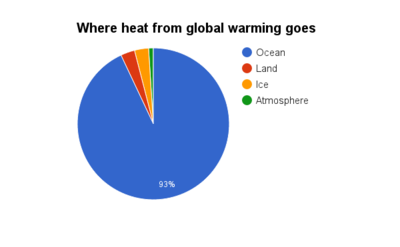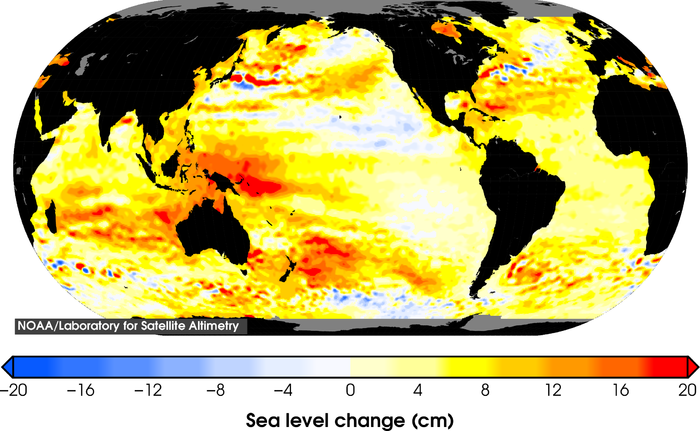Ocean heat

Ocean heat is the energy associated with the change in average ocean surface and bulk temperatures as a result of both natural and human activities. This heating comes as a result of increased greenhouse gas levels in the atmosphere, which are known to be attributed to human emissions.[2]
Ocean warming accounts for roughly 93% of the additional energy stored from heat on the Earth, with the other 7% including all of the Earth's atmosphere (1%), land (3%) and ice (3%) (see Figure 2). The upper 700 meters of the ocean contributes much more to this value, since it is harder for light to penetrate into deep ocean layers, and heat transfer by conduction and other ocean currents is generally slow.[3] The distribution of this warming is not uniform, as can be seen from Figure 1, and depends on ocean water circulation.

Impacts of this warming
The knowledge of how oceans have changed in recent years is extremely important, however due to its coupling with the atmosphere it is also extremely complex. Since both the atmosphere and ocean transfer heat from the equator to higher latitudes, any modification in ocean circulation can be a source of climate change. It is also important because any sea level increase directly affects highly population coastal areas.[5]
Changes in ocean salinity
Ocean salinity can change for various reasons as a result of warming:[5]
- An influx of fresh water from melting sea ice, which reduces salinity
- Increased evaporation of sea water, which increases salinity
- An increased influx of fresh water from rain, rivers or land ice, which reduces salinity
In general, as the intensity of the hydrologic cycle (water cycle) increases, as is expected with global warming, the salinity of oceans is expected to change more drastically.
Melting of ice
The melting of ice - particularly sea ice - and corresponding decrease in albedo is of great concern. Ice is white and highly reflective - corresponding to a high albedo (reflectivity). This reflectivity prevents some incident sunlight from being absorbed.[6] However, when ice melts the vegetation, soil, or water beneath it is exposed. These surfaces are darker and heat faster and thus have a lower albedo. As these surfaces with a lower albedo are exposed to the Sun, they absorb more solar radiation than the ice would have. This absorption further raises temperatures and causes even more ice to melt, continuously heating and pushing the cycle, known as a positive feedback cycle. This feedback can act more quickly over the ocean than over land as sea ice is able to melt more quickly than large, continental ice sheets.[7]
The melting of ice also contributes to the next major consequence of ocean heating; rising sea levels.
Changes in sea level
The increase in ocean temperatures has caused an increase in sea level by about 20 centimeters. There are two reasons for warming oceans to cause an increase in sea level:[5][8]
- Molecules gain more kinetic energy at higher temperatures and cause the water to take up more space. This is known as thermal expansion. (~1 mm/year)
- This extra heat causes sea ice sheets to melt. Greenland and other Arctic locations are warming twice as fast as other locations on Earth. (~2 mm/year)

The increase in sea level is concerning as 11 of the world's 15 largest cities lie on the coast, meaning that more people are at risk of harsh events like floods and hurricanes. Not only does it affect people's safety in these cities, but the damage such events can have is expected to cost a tremendous amount of money - in 2015 flooding in major coastal cities costs about $6 billion (USD) worldwide, and could increase to nearly $1 trillion by 2050.[8]
References
- ↑ NOAA. (Accessed December 28, 2015). Climate Change Web Portal [Online], Available: http://www.esrl.noaa.gov/psd/ipcc/
- ↑ IPCC, FAQ: What Factors Determine Earth’s Climate? [Online], Available: https://www.ipcc.ch/publications_and_data/ar4/wg1/en/faq-1-1.html
- ↑ 3.0 3.1 M. Melieres and C. Marechal, "Recent Climate Change," in Climate Change: Past, Present and Future 1st ed., U.K.: Wiley, 2015, ch.25.1.3, pp. 248-249
- ↑ Created internally by a member of the Energy Education team.
- ↑ 5.0 5.1 5.2 M. Melieres and C. Marechal, "The impact of warming on the ocean," in Climate Change: Past, Present and Future 1st ed., U.K.: Wiley, 2015, ch.27, pp. 273-283
- ↑ NASA Global Climate Change. (October 10, 2015). The Study of Earth as an Integrated System [Online]. Available: http://climate.nasa.gov/nasa_role/science/
- ↑ Climate Communication. (October 10, 2015). Climate Warming Feedback [Online]. Available: https://www.climatecommunication.org/climate/climate_feedbacks/
- ↑ 8.0 8.1 NASA. (Accessed November 7 2015). Sea Level Rise [Online], Available: http://climate.nasa.gov/climate_resources/125/
- ↑ NOAA/NESDIS. (Accessed December 28, 2015). Sea Level Rise [Online], Available: http://www.star.nesdis.noaa.gov/sod/lsa/SeaLevelRise/

